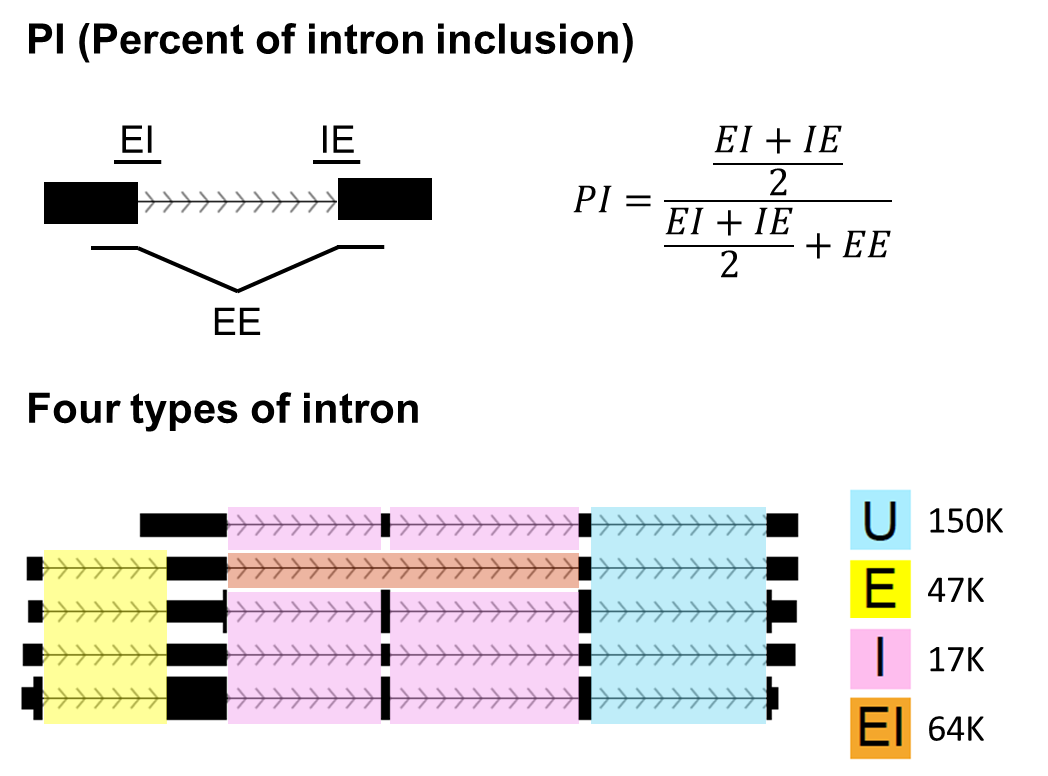SIRI is a general tool for quantifying the percent of intron inclusion in RNA-seq data. It adopts parts of functions from SQUID and rMATS-turbo.
SIRI is dependent on pysam.
Please make sure that SIRI is running under python 2.7.x environment and pysam is installed before running SIRI.
You can install SIRI from source:
git clone https://github.com/Xinglab/siri.git
../bin/SIRI --gtf test.gtf --bam test_R1.bam,test_R2.bam --anchor 8 --length 100 --lib first --read P -o SIRI_Output
Detailed arguments:
usage: SIRI
--gtf:
gtf files provided for PI estimation.
--bam/bam_files:
s1.bam/s1.sam[,s2.bam/s2.sam]. STAR mapping results for all of samples in bam/sam format. Different samples are separated by commas.
--anchor:
The anchor length in nucleotide. The program will only count reads spanning junctions with at least this anchor length on each side. The default is 8.
--length:
The length of reads specified by user.
--lib:
The library type with choices of unstrand/first/second. The default is unstrand.
-o:
The output directory of results.
--read:
The sequencing strategy of producing reads with choices of P(paired end) or S (single end). The default is P
SIRI takes a bam file or multiple bam files as input.
It also requires a reference gene annotation.
The folder contains the final output of PI quantification (intron.PI.txt).
The detailed explanation of column names for Intron_PI.txt.
Intron_id: Intron Id representing the chromosome position, start and end (1-index based)
Gene_id: Gene id of intron residing genes
Strand: Strand of intron residing genes
Chr: Chromosome name of introns
Start: Start coordinate of introns
End: End coordinate of introns
Annotated: Whether this intron was annotated in the gtf file as retained intron event
Attributes: One of the four intron types, U/E/I/EI
Inclusion_counts: Inclusion junction counts separated by commas
Skipping_counts: Skipping counts separated by commas
Inclusion_counts_with_intron_body: Inclusion junction counts plus counts from intron body.
Inclusion_length: Effective inclusion junction length
Skipping_length: Effective skipping length
Intron_body_length: Effective inclusion and intron body length
PI_Junction: PI_Junction value separated by commas
PI_JunctionIntron: PI_JunctionIntron separated by commas
Inclusion counts divided by the sum of inclusion and skipping junction counts.
Sum of inclusion counts and intron body counts divided by the sum of inclusion, skipping junction counts and intron body counts.
U:
Introns that are not partly overlapped with exons or overlapped with other introns.
E:
Introns that are partly overlapped with exons but not overlapped with other introns.
I:
Introns that are overlapped with other introns but not overlapped with exons.
EI:
Introns that are both overlapped with exons and other introns.
An intermediate folder contains different types of gtf files to run the program. Use test.gtf as examples.
test.gtf: the ensembl gtf files. This file should be provided by user.
Exon_test.gtf: the gtf file contains exons only
Intron_test.gtf: the gtf file contains intron only
Intron_Annotated_test.gtf: the gtf file contains the attributes whether the intron was annotated as retained introns in the original gtf files
Intron_attri_test.gtf: the gtf file contains the attributes whether the intron was overlapped with Exon and whether the intron is overlapped with other introns.
An intermediate folder contains all of the count files
count_intron.txt: a file contains the counts for all of the introns
column 1: Intron Id representing the chromosome position, start and end.
column 2: Gene id
column 3: Strand
column 4: Comma separated logical values to denote Whether this intron was intron (E) or intron (I) based on read info
column 5: Chromosome name
column 6: Start coordinate
column 7: End coordinate
column 8: Inclusion counts at 5' splice sites for sample 1
column 9: Skipping counts at 5' splice sites for sample 1
column 10: Inclusion counts at 3' splice sites for sample 1
column 11: Skipping counts at 3' splice sites for sample 1
column 12: Skipping counts of the intron for sample 1
column 13: counts lying in the intron for sample 1
column 14~6*(n+1)+1: more counts for samples 2~n
count_exon.txt: a file contains the counts for all of the exon in each gene
column 1: Gene id
column 2~ n+1: Gene counts in samples 2~n
column n+2: Gene strand
column n+3: The chromosome of the gene
Copyright (C) 2020 Children’s Hospital of Philadelphia, University of Pennsylvania Yi Xing
Contributors: Zhicheng Pan, Shaofang Li, Yi Xing
This program is free software: you can redistribute it and/or modify it under the terms of the GNU General Public License as published by the Free Software Foundation, either version 3 of the License, or (at your option) any later version.
This program is distributed in the hope that it will be useful, but WITHOUT ANY WARRANTY; without even the implied warranty of MERCHANTABILITY or FITNESS FOR A PARTICULAR PURPOSE. See the GNU General Public License for more details.
You should have received a copy of the GNU General Public License along with this program. If not, see http://www.gnu.org/licenses/.
Zhicheng Pan zcpan1016@gmail.com
Yi Xing yi.xing@pennmedicine.upenn.edu
